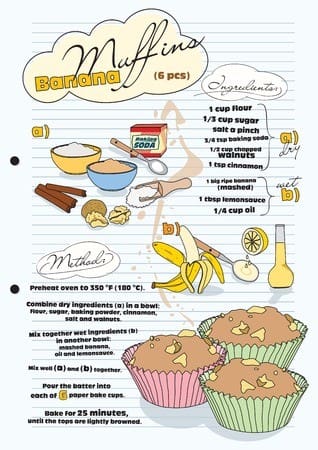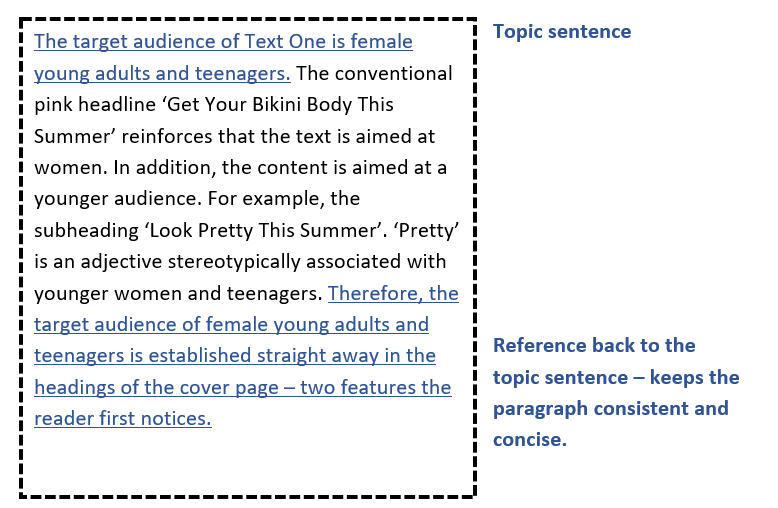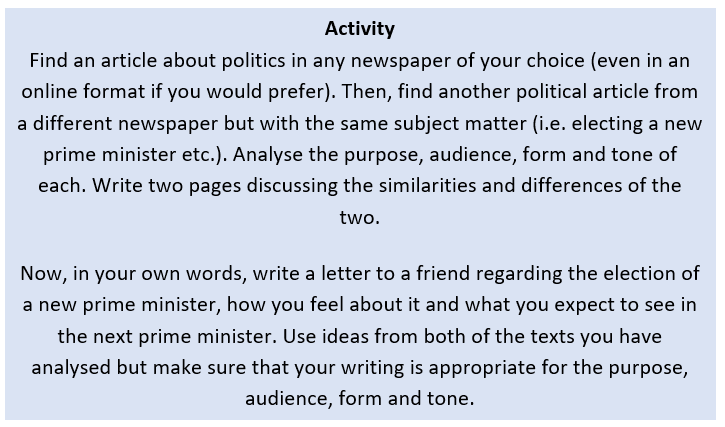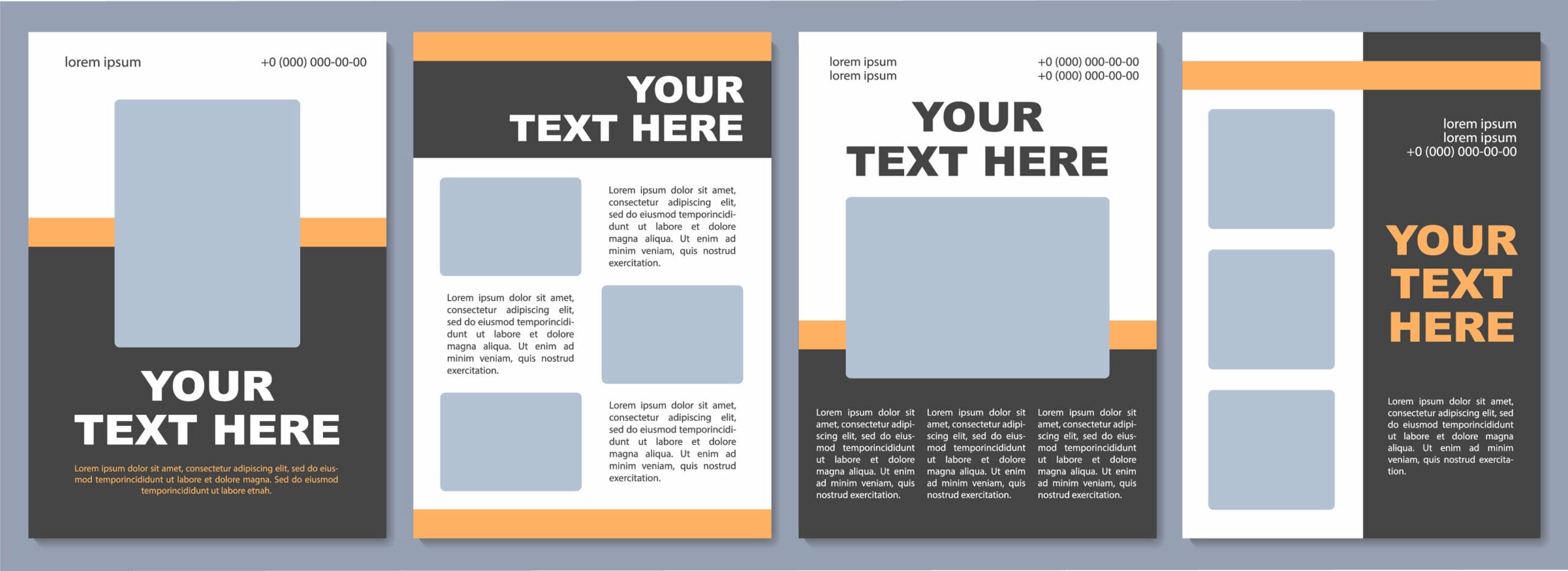In this post
Purpose
The purpose of a text means analysing what the text is for and what it is trying to achieve. Below is a list of the different types of purpose that a text can have:
- To advise
- To analyse
- To argue
- To inform
- To entertain
- To explain
- To instruct
- To persuade
- To review
- To describe
Some categories of texts have specific purposes. For example, any form of advertisement always has a purpose to persuade as the text will be wanting the reader to buy something. The purpose of a text can greatly affect how it is structured, its content, the language used and the literary devices that are used, which is why it is an essential aspect of writing to learn.
A text may just have one purpose but you need to be aware that it might have more than one. There are many different purposes that a text can have; for example, if someone is writing a letter to apply for a job then it will have a purpose to inform the employer of their qualifications and experience, to explain why they are the right fit for the role and to persuade the employer to give them the job.
When you are writing your own texts, you should ask yourself the following questions:
- What are you wanting to achieve from someone reading your text?
- Will a specific layout or structure need to be adapted in order for you to achieve this effectively?
- What language style will you need to adopt in order for the text to suit the requirements of its purpose, target audience and chosen genre?
We will now discuss the individual features of these purposes.
To Advise
A text that is written to advise is trying to help people decide what to do, or how to do something. When writing a text with a purpose to advise, it is important to come across to the reader as friendly. It is no good using the same techniques as you would use to persuade people. This is because you are not trying to persuade anyone to do anything but instead advise on the best cause of action. An example of when you might be required to write a text to advise is if you are asked to write a letter to a friend to offer them advice on how to prepare for a job interview.
To Analyse
A text that is written to analyse is designed to find out more information about a topic and to break down information to help people understand it better. Often when texts have a purpose to analyse they also have a purpose to explain. Texts to analyse include the essays that you will be asked to write in your exam. For example, in Section A, you will be analysing two texts to work out why the writers have used the certain techniques that they have.
To Argue
Also known as argumentative writing, texts to argue are written to make a case about a particular issue, statement, course of action, event etc. Often, texts to argue also have a purpose to persuade and so many rhetorical devices will be used throughout. An important aspect to remember when writing a text with a purpose to argue is to make sure that you present a balanced argument. If you do not present a balanced argument, it is likely that your writing will come across as biased and unreliable to the reader. Argumentative writing is an important area to look at when preparing for Section C of the exam, therefore we will explore this and how to recognise and apply different rhetorical devices in much more detail in Unit 4.
To Inform or Explain
A text that has a purpose to inform or explain is normally non-fiction (real life). These texts can include, posters, magazine/newspaper articles, letters, emails, reports, essays, leaflets etc. When you write to inform or explain, you are effectively telling your readers about a topic that they may not know much about; something as common as a bus timetable is a text that has a purpose to inform. This means that these texts should be set out simply and clearly so the audience can easily understand the information you are providing; this may include structuring the text with headings and subheadings. If the text is an essay, this means you must have a clear structure and writing style – this includes your essays that you will write in your exam when you analyse texts in Section A. Here are some common things to remember when you are writing to inform or explain:
- A Detached Tone: if a text has a purpose to inform or explain then it will normally have a detached tone and be written in the third person (no first or second person pronouns: ‘I’, ‘me’, ‘you’ – except in report writing). A text to inform or explain is providing facts, so when you are writing your own text with either of these purposes it is important to have a detached tone so you do not come across as biased; even though report writing is commonly written in first person, the language is always objective.
- The 5 W’s: be specific – use the 5 W’s when writing a text to inform or explain – who, what, where, when and why.
Very occasionally, a text with the purpose to inform or explain will require you to have a more personal tone. For example, you may be writing a letter to someone and informing them about your life or explaining a situation you are involved in. If this is the case, then using the first person personal pronouns ‘I’ and ‘me’ and the second person ‘you’ will be appropriate.
Although the above list is applicable for most texts with the purpose to inform or explain, the tone, structure and words you use will be dependent on who the target audience is for the text and if it also has another purpose other than to inform – we will discuss the audience of texts after we have gone through the different purposes.
To Entertain
When we are talking about texts to entertain we could be talking about any form of a story, a poem, a script for television, radio, film, the stage or a transcript of a song etc. It is easy to recognise a text that entertains. You may often find that some advertisements have both a purpose to persuade and to entertain. Normally, a text with the purpose to entertain is fictional (imaginary/not real). However, an advertisement is based on a real object. Even a celebrity magazine article will have a purpose to inform but also to entertain the reader – the information contained in these are supposed to be factual but this does not prevent it from having a purpose to entertain.

There are a few features that you may find in texts with the purpose to entertain (however, bear in mind that not all texts will have these features):
- Colloquial Language: a ‘chatty’ style will sometimes be adopted to the language to create a more personal tone – this is common in informal magazine articles (but not often found in newspapers) and scripts; this is in terms of the character’s dialogue as it is written in a way that mimics spoken language.
- Humour: this can include sarcasm, irony, satire etc.
- First/Second Person: the first/second person is commonly used in texts to entertain. This can create a close relationship between the reader and the writer which can make the reader feel more involved.
- Scripts: if a text is a script, more often than not it will have a purpose to entertain. Every film script, for example, has the purpose to entertain. However, you could also say that it has the purpose to instruct as the script is instructing actors on what to do and say. Be aware that not all scripts have the purpose to entertain; for example, a script for a news channel would have the purpose to inform and occasionally to instruct or explain also.
To Instruct
Texts that have the purpose to instruct are not as common as texts that have the purpose to entertain or to inform. They mainly consist of recipes and instruction manuals. However, as mentioned above, you could say that a film script instructs actors on what to say and do on set.
When writing recipes or instruction manuals you have to be very precise. Even if you think that you would pre-heat an oven before cooking anything, you cannot expect everyone else to think the same. Keep the instructions easy to understand – this means you should avoid including any jargon, and instead keep everything relevant and in chronological order (this means following the order of things in which they occur). Take a look at the following example of a recipe:

As mentioned previously, you are not required to include any images in the exam so a purely text based recipe has been provided for you below:
| Chocolate Chip Cookies RecipeIngredients100g butter80g brown sugar1 egg100g caster sugar200g of milk chocolate chips (or white if you would prefer)1tsp vanilla extract200g self-raising flourMethod1) Pre-heat the oven to 180o (gas mark 4)2) Mix the butter and sugars into a large bowl3) Add the vanilla extract and the egg to the mixture4) Sift in the self-raising flour5) Add the chocolate chip pieces to the mixture6) Roll the mixture into walnut sized balls and place on ungreased baking paper7) Transfer to oven and cook for approximately 9 minutes8) After 9 minutes take the cookies out of the oven and leave to stand for 2 minutes before transferring to a cooling rack |
To Persuade
A text to persuade includes an opinion or an idea from the writer that is designed to get the reader to think a certain way or to take action against something. Persuasive writing is common in speeches, posters and advertisements. You will get the choice to write a piece of persuasive writing in Section C of the exam.
There are a few features which are common when writing to persuade:
- Emotive Language: this involves using language with the intention that it will have an emotional impact on the audience. Emotive language is created through the use of adverbs and adjectives. These can either be positive or negative, and depending on which it will have a certain effect on the reader. You need to not only be able to recognise if a text has emotive language and what effect it has on you as a reader but also how you can include emotive language in your own writing to create a desired effect.
- Connotative Words: these are words that have underlying meanings or emotional overtones. You may recognise this term from when we discussed it in Unit 1 under the ‘Literary Devices’ chapter.
- Rhetorical Questions: rhetorical questions are questions that appear in a text but are not meant or expected to be answered by anyone in particular. The device is used to get the audience involved and thinking about a certain subject or situation. It is often a good technique in getting people to agree with you and is used a lot in political speeches etc., for example, ‘Who are they kidding?’ From this example, you may have already noticed that some rhetorical questions are a form of sarcasm.
- Speaking Directly to the Reader: a lot of persuasive texts speak directly to the reader. This is either using first person and second person personal pronouns – ‘I’, ‘me’, ‘we’, ‘us’, ‘you’ – or through opening statements such as ‘Who could deny that…’, ‘All sane people will agree that…’ and ‘It cannot be disputed…’. These statements effectively manipulate the reader into agreement as it makes them want to feel included.
There is a basic structure that you can use to plan any persuasive essays in the exam.
| Introduction:Include a topic sentence that gets to the point immediately and makes it clear to the reader/examiner what you are going to write about.Try to include a hook like you would at the beginning of a story; this will grab the reader’s/examiner’s attention which will gain you marks.Write your whole essay in third person. |
| Paragraph 1:State your argument (only writing in third person).Back up your argument with facts (these can be quotes from a particular text, numbers and figures). |
| Paragraph 2:State a counterargument to your argument so you are providing two sides of the story – this makes you seem more reliable.v Again, back up the argument with facts (these can be quotes from a particular text, numbers and figures). |
| Paragraph 3:Compare the arguments. If necessary, speak about future problems that may occur due to the counterargument you have made. |
| Conclusion:Conclude with a summary of the benefits of your argument. Use devices such as rhetorical questions to keep the audience thinking long after they have read your argument. |
To Review
Texts that have the purpose to review are evaluations of things or situations. These can include reviews on objects, books, films, television programmes, restaurants, businesses, holidays, a service that has been received by a customer etc. You will see these a lot on the internet as some businesses like to display these on their website as a way of promoting their company to other prospective customers. Reviews consist of:
- Background Information: a review normally begins with a bit of background information on the object, book, film etc. This can include what it does, when you bought/read/watched it, the director/producer of the film – any one of a number of things.
- Summary: if the review is in regards to a particular service or event, a summary of it will be included. This gives the reader the full picture.
- Recommendations: most reviews have the aim of either recommending something or trying to get other people to steer clear of bad products or services.
- Opinionated: some reviews remain objective but some are very highly opinionated and have another purpose, to persuade. However, if you are trying to persuade as well as review, for the reader to have trust in what you are saying, it is important to be as unbiased and as objective as you can – otherwise you may come across as unreliable.
To Describe
When a text has the purpose to describe, the writer is doing exactly that: describing. The purpose to describe can appear in any text; you could be describing what whisk to use in a recipe, what someone looks like in a story/song, describing a place/object etc. However, if a text has a purpose to describe, chances are it also has another purpose too; bear this in mind when you are analysing texts.
Describing is an essential purpose for telling a story. This can consist of both fiction and non-fiction stories. Descriptive writing is a large aspect of Section C of the exam. Therefore, we will cover this in more detail in the next unit of this course.

Audience
The audience of a text is who the text is aimed at, or, in other words, who would read it. An audience can consist of a variety of people. For example, you could say a glossy celebrity magazine is aimed at female young adults and teenagers. When you are asked to analyse a text, you are not expected to just be able to state the audience. You must explain why you think that it is aimed at that particular audience (although you are talking about your own opinion here, you must never write in first person in an essay, always write in third person).

Let’s imagine we have a celebrity magazine in front of us. An example of how we might explain who the audience of the text is has been provided.

In the above example notice how concise and relevant every piece of information is. Referencing back to the topic sentence at the end of the paragraph is a good technique to use in your own writing when you are asked to analyse texts. Using these techniques will show the examiner that you are able to write coherently and are able to structure your work effectively – this will gain you extra marks in the exam (as long as the information you are including is always relevant to the question being asked).
Being able to recognise and explain why a writer has chosen certain features to appeal to a specific audience will allow you to be able to target an audience appropriately in your own writing.
Any text that you are asked to analyse in the exam requires you to read it from the audience’s perspective. In an exam, you are the audience so you must write about what effect the text has on you (however, remember not to write in first person in an essay, always write in third person instead). If the text does not appeal to you specifically, start thinking about who it would appeal to. Once you know the type of audience you are aiming your text at, it is important that you attempt to put yourself in their shoes. This way, you will know exactly what they want and expect so you can make sure that you include everything that might appeal to them. Do not narrow down the audience too much though; it is better to have a wider audience. The exam question may even tell you who the text is aimed at anyway.
An example would be if you are asked to write a poster to inform people about the dangers of smoking. Here, you will have a wide target audience as the text will be relevant for both genders and different types of people. However, it will mostly be aimed at adults and teenagers so the language will have to be sophisticated – but not too complicated as, after all, it is a poster. The poster will also have the purpose to advise the audience on the health risks and to persuade them to either not start smoking or to quit smoking altogether.
Due to the serious implications of smoking, the language will have to reflect the health hazards. This means that Standard English should be used throughout. Although it has a purpose to inform, the other purpose to persuade may result in the use of emotive language to help persuade the audience. Due to the form being a poster, the sentences and paragraphs (if any) will be short and snappy to grab the reader’s attention, but simplifying it too much will exclude the adult audience. The audience/reader is the key aspect when you write any piece of writing. You need to pay particular attention in becoming proficient in both recognising a text’s audience and also effectively applying one to your own writing.
Form and Tone
Form
The form of a text is in reference to its structure, layout and any images that are included. Different types of texts have conventional formats. For example, a letter will always have the sender’s address at the top right-hand corner; this is one of the conventions of a letter. You need to be aware of the different types of texts and their conventional formats. We will go into this in detail later in this unit. An activity regarding form will be provided for you at the end of this unit. In the exam, you will be expected to be able to identify the key aspects of different forms of writing, especially when you begin writing your own pieces.
Tone
The tone of a text refers to the attitude towards the subject matter of the piece of writing. In other words, the feeling in which the words are spoken with. However, it can also refer to the level of formality of the piece.
The tone of a piece of writing is required to be tailored for specific audiences. Any text you read or write, both in the exam and in real life, will have a specific tone. Look at the possible scenarios you may come across below:
- If you are ever required to write a letter to a friend, it will have an informal, friendly tone. It will be written in the first person, perhaps with some exclamatives and other techniques that will add to the informal and friendly tone of the letter.
- If you consider the tone of a political speech, you will find that they have a very formal and passionate tone. First person (‘I’, ‘me’) and second person (‘you’) personal pronouns will be used in order to make the speech appear more personal and to make the audience feel more involved. Another technique that is often used in political speeches to create a more personal tone is the use of rhetorical questions. All of these factors add to the tone of the speech which will help give off a desired impression intended by the writer. A politician’s purpose is normally to persuade and so they aim to appear honest and sincere about the point they are making.
At the end of this unit, questions regarding purpose, audience, form and tone will be provided for you that you must complete before submitting to your tutor for marking.
Practising PAFT
As you have probably noticed, the purpose, audience, form and tone of a text should be thought of collectively. Each one needs to be decided to suit the other and will affect the content and language contained within the text.
You will need to practise recognising the purpose, audience, form and tone of texts so that you are fully prepared and able to pass the exam. Below is an activity similar to what you will be asked in the Section B exam question. In order for you to pass your English Language exam, you will need to be able to recognise the purpose, audience, form and tone of a variety of texts. Therefore, constant practising of personal activities (like the one below) is vital if you are serious about passing.

You can practise this task regularly; simply pick out two texts from the internet, a magazine, a letter (this could be anything from a personal letter to a utility bill), a newspaper, a book etc. that have similar content and analyse and compare them. Once you have done this, write about the same content but in a different form than the two texts you have chosen (e.g. diary/journal entry, script, story, letter, article etc.).
Now that we have explored the different purposes, audiences, and tones of a text, we will now look into the different texts you may be asked to write in the exam and their individual forms.



